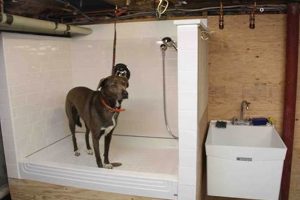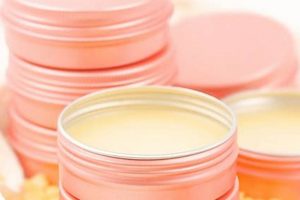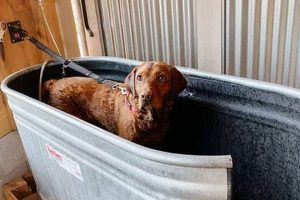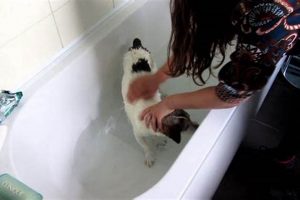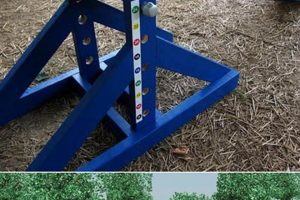A barrier constructed within a home, typically from readily available materials or repurposed items, designed to restrict canine access to specific areas. These enclosures are often implemented to manage pet behavior, protect delicate objects, or provide designated safe spaces for the animal or other household members. Common examples include structures made from wood, metal pipes, or even repurposed furniture, adapted to fit doorways or hallways.
The utilization of such barriers offers several advantages. These include the cost-effectiveness of using existing resources or inexpensive materials, the ability to customize dimensions and aesthetics to perfectly suit a home’s layout and decor, and the empowerment of owners through a hands-on approach to pet management. Historically, homeowners have employed makeshift partitions for similar purposes, evolving from simple fabric screens to more structurally sound and visually integrated solutions.
The subsequent discussion will delve into the selection of appropriate materials, explore various construction techniques, and offer guidance on ensuring both the safety and aesthetic appeal of these pet containment solutions.
Considerations for Constructing a Barrier to Restrict Canine Movement Within the Home
The construction of an interior pet barrier requires careful planning and execution to ensure both the animal’s safety and the structure’s functionality. The following guidelines provide essential considerations for a successful project.
Tip 1: Material Selection: Prioritize non-toxic and durable materials. Untreated wood, while aesthetically pleasing, may splinter. Metals should be free of sharp edges and coated with pet-safe finishes. Avoid materials that could pose a choking hazard if ingested.
Tip 2: Height and Spacing: Determine appropriate height based on the dog’s breed and jumping ability. Vertical bar spacing should be narrow enough to prevent the animal from squeezing through. A general guideline is a maximum spacing of 2-3 inches.
Tip 3: Secure Mounting: The structure must be securely anchored to walls or doorframes. Pressure-mounted systems are suitable for some situations, but hardware-mounted solutions offer greater stability, especially for larger breeds.
Tip 4: Smooth Surfaces: Eliminate any sharp corners or protruding hardware to prevent injury. Sand rough edges and countersink screws or nails. Consider using edge banding for added safety and visual appeal.
Tip 5: Gate Functionality (If Applicable): If a hinged gate is incorporated, ensure smooth operation and a reliable latching mechanism. The latch should be easily operable by humans but inaccessible to the dog.
Tip 6: Aesthetics: While functionality is paramount, consider the barrier’s visual integration with the home’s decor. Paint, stain, or other finishes can enhance the structure’s aesthetic appeal.
Tip 7: Gradual Introduction: Introduce the dog to the new barrier gradually. Use positive reinforcement, such as treats and praise, to create a positive association with the confined space.
Adhering to these guidelines will result in a safe, functional, and aesthetically pleasing solution for managing canine movement within the home. Prioritizing the animal’s well-being throughout the construction process is essential.
The subsequent section will examine specific design ideas and offer detailed instructions for constructing various styles of barriers.
1. Material Safety
Material selection in the construction of a DIY indoor pet containment solution directly impacts the health and safety of the animal. The physical and chemical properties of chosen materials must be rigorously evaluated to prevent potential harm. The selection process extends beyond structural integrity, requiring a thorough understanding of toxicity and allergenic potential.
- Toxicity of Finishes
Paints, stains, and sealants applied to wood or metal components can contain volatile organic compounds (VOCs) or heavy metals that are harmful if ingested. Only pet-safe, non-toxic finishes, certified to meet relevant safety standards, should be employed. These certifications typically indicate that the product has been tested and found to emit minimal or no harmful substances under normal conditions of use. For example, using a lead-based paint can lead to lead poisoning if the animal gnaws on the structure.
- Wood Treatment Chemicals
Pressure-treated lumber, commonly used for outdoor applications, contains chemicals designed to prevent rot and insect infestation. These chemicals can leach out and pose a risk to animals. Untreated wood is generally a safer option for indoor pet containment, although it may require additional protection against moisture. Alternatives such as naturally rot-resistant woods (e.g., cedar) can be considered, ensuring they are free from any chemical treatments.
- Metal Composition and Coatings
Metals used in the construction of the structure, such as bars or framing, should be non-corrosive and free from lead or other toxic elements. Galvanized steel, while durable, may contain zinc, which can be harmful if ingested in large quantities. Powder coating provides a durable, non-toxic finish that can protect the metal from corrosion and prevent the animal from coming into direct contact with potentially harmful substances. Stainless steel represents a corrosion-resistant and generally safe alternative.
- Fastener Security and Material
Screws, nails, and other fasteners used to assemble the barrier must be securely installed to prevent detachment and ingestion by the animal. Sharp edges and protruding points should be avoided. The composition of the fasteners themselves should also be considered; for instance, using rust-resistant materials minimizes the risk of corrosion and subsequent ingestion of rust particles. Consider using recessed fasteners and covering them with wood filler, or using non-toxic caps to protect curious pets.
The inherent characteristics of construction materials dictate their suitability for pet-related applications. Prioritizing non-toxic options, implementing appropriate protective coatings, and ensuring secure assembly are paramount to creating a safe and functional pet containment solution within the home. This reduces any health risks and enables a secure barrier for pets at home.
2. Structural Integrity
The successful implementation of a pet containment barrier within a home hinges upon the structure’s ability to withstand forces exerted by the animal. This load-bearing capacity, or structural integrity, directly correlates with the effectiveness and longevity of the barrier. Insufficient structural design leads to potential breaches, rendering the structure useless and possibly creating hazards for the pet. For example, a gate constructed from thin, unsupported wood may collapse under the weight of a large dog attempting to lean or jump on it. This not only compromises containment but also poses a risk of injury to the animal.
Achieving adequate structural integrity necessitates careful consideration of materials, joinery, and load distribution. The chosen materials must possess sufficient strength and rigidity to resist deformation under anticipated stress. Secure joinery techniques, such as mortise and tenon, dovetail, or robust screwing methods, are critical to prevent component separation. Additionally, proper load distribution through supporting members ensures that the structure can effectively bear the weight and force exerted by the animal. For instance, adding vertical supports to a wider gate or reinforcing corners with metal brackets can significantly increase its resistance to stress.
Ultimately, the structural integrity of a pet barrier dictates its performance and safety. Understanding the principles of load-bearing, material strength, and secure construction is essential to creating a reliable barrier. Neglecting these considerations can lead to structural failure, compromising containment and potentially endangering the pet. Therefore, rigorous attention to detail and adherence to sound engineering principles are paramount to ensuring the long-term effectiveness and safety of the structure. Designing with a safety factor, accounting for the maximum possible force the dog can exert, is always prudent.
3. Adjustable Dimensions
The capacity to modify the physical parameters of a pet barrier during construction presents a significant advantage in its deployment within diverse domestic environments. This adaptability, often referred to as adjustable dimensions, ensures the final structure corresponds precisely to the intended location, optimizing functionality and minimizing spatial disruption.
- Width Accommodation
Doorways, hallways, and staircases exhibit variable widths across different residences. A prefabricated barrier of fixed dimensions may not effectively span the available space, creating gaps that allow pet egress or requiring invasive structural modifications to the home. The creation of a barrier with adjustable width mitigates these issues, allowing for precise adaptation to the existing architecture. An example would be a telescoping side panel on a wooden gate, enabling it to fit openings ranging from 30 to 48 inches.
- Height Considerations
The height of the barrier must be sufficient to prevent the animal from jumping over it, which varies depending on the breed, size, and athletic ability of the dog. Adjustable height features, such as modular panel systems or extendable legs, provide a means to fine-tune the vertical dimension of the barrier to effectively contain the pet without unnecessarily obstructing human passage or impacting visibility. An owner of a small terrier might require a significantly lower barrier than the owner of a large breed such as a Great Dane.
- Terrain Adaptation
Floor surfaces are rarely perfectly level. Slight variations in elevation, particularly at the base of staircases or in older homes, can compromise the stability of a fixed-dimension barrier. Adjustable feet or leveling mechanisms address this issue, ensuring a secure and even placement of the structure regardless of minor irregularities in the underlying surface. This prevents wobbling and reduces the risk of the pet dislodging the barrier.
- Customizable Panel Configuration
Certain spaces may require the barrier to follow an irregular path or incorporate angles. Modular panel systems, which allow for the addition or removal of sections and the adjustment of connecting angles, enable the creation of custom configurations that perfectly conform to the unique geometry of the area. An example is a folding gate with multiple hinges, that can be shaped to be octagonal or linear.
These adjustable dimensions play a crucial role in optimizing the fit and functionality of a custom-built pet barrier. Accurate accommodation of spatial constraints, terrain irregularities, and pet behavioral characteristics ensures the construction of a secure and aesthetically integrated solution.
4. Aesthetic Integration
Aesthetic integration, within the context of constructing a pet containment solution, refers to the harmonious blending of the barrier’s design with the existing decor of the home. This consideration transcends mere functionality, recognizing that a barrier, while serving a practical purpose, also becomes a visual element within the living space. Prioritizing aesthetics ensures the barrier does not detract from the overall ambiance and perceived value of the home.
- Material Selection & Harmonization
The choice of materials exerts a substantial influence on the barrier’s visual impact. Selecting materials that complement existing architectural elements, such as wood trim, flooring, or hardware finishes, contributes to a cohesive aesthetic. For instance, a home with dark wood accents might benefit from a barrier constructed from stained wood or powder-coated metal in a similar dark hue. Conversely, a modern home with minimalist design may favor a barrier constructed from clear acrylic panels or stainless steel.
- Color Palette & Coordination
The color scheme of the barrier should align with the surrounding environment. Employing neutral colors or selecting shades that match or complement the existing wall color minimizes visual disruption. In some instances, a contrasting color can be used to create a deliberate design statement, but this approach requires careful consideration to avoid clashing with the overall aesthetic. Subtle patterns or textures can also be incorporated to add visual interest without overwhelming the space. An example is a barrier painted in a shade that matches the trim color, effectively blending it into the wall.
- Design Style & Consistency
The overall design of the barrier should be consistent with the architectural style of the home. A traditional home might benefit from a barrier with ornate details and classic lines, while a contemporary home would likely be better suited to a minimalist design with clean lines and simple geometric forms. Incorporating design elements that echo existing architectural features, such as arched doorways or decorative moldings, can further enhance aesthetic integration. A Victorian-era home, for example, might benefit from a barrier with spindle details or a decorative crest.
- Hardware & Finishing Details
The selection of hardware, such as hinges, latches, and knobs, also contributes to the overall aesthetic. Choosing hardware with a finish that complements the other metal fixtures in the home, such as brushed nickel, polished brass, or matte black, creates a sense of visual unity. Attention to detail in the finishing of the barrier, such as smooth sanding, even paint application, and concealed fasteners, further enhances its aesthetic appeal. High-quality hardware and meticulous finishing elevate the barrier from a purely functional object to a design element that enhances the home’s overall aesthetic.
By thoughtfully considering material selection, color palette, design style, and finishing details, a homeowner can create a pet barrier that effectively serves its intended function while seamlessly integrating into the existing aesthetic of the home. This holistic approach ensures the barrier enhances, rather than detracts from, the visual appeal of the living space, reinforcing its overall value and comfort. The aesthetic of the home is often important to those that choose to pursue a “diy indoor dog gate” project.
5. Pet Accessibility
Pet accessibility, in the context of constructing a “diy indoor dog gate,” refers to the design considerations that allow for differential access for various household animals. The primary cause for needing a modified design stems from variations in size, agility, and behavioral characteristics among different species. An unmodified barrier, designed solely for canine containment, may inadvertently restrict the movement of other pets, such as felines, leading to unintended confinement or stress. Therefore, the inclusion of pet accessibility features is a crucial component of comprehensive pet management within a shared living space. A real-life example would be a gate designed to keep a dog in a certain room, while allowing a cat to jump over the gate or pass through a small opening, ensuring that the cat still has access to its litter box or food.
The practical significance of understanding this interconnectedness lies in the promotion of a harmonious multi-pet household. Integrating smaller openings, elevated platforms, or bypass routes within the “diy indoor dog gate” structure ensures that cats or other smaller animals can navigate the home without impedance. One strategy involves incorporating a “cat door” or a raised passageway that is inaccessible to the dog, granting the feline freedom of movement. This approach not only addresses the needs of different species but also minimizes inter-species conflict arising from perceived territorial restrictions. Another application involves the design of modular systems where additional panels or sections can be easily added or removed to adjust the accessibility for different pets.
In summary, pet accessibility is a vital aspect of designing a “diy indoor dog gate,” particularly in multi-pet households. Addressing the unique needs of each animal species through thoughtful design modifications enhances their well-being and promotes a more balanced domestic environment. While challenges may arise in balancing the needs of different animals within a single barrier design, prioritizing pet accessibility ultimately contributes to a more harmonious and comfortable living situation for all inhabitants.
Frequently Asked Questions
The following section addresses common inquiries regarding the construction and implementation of interior pet containment solutions. These questions aim to clarify key considerations and provide practical guidance for individuals undertaking such projects.
Question 1: What constitutes a safe material for building a DIY interior pet enclosure?
Materials deemed safe are those that pose minimal risk of toxicity, splintering, or ingestion. Untreated wood, properly sealed with non-toxic finishes, and powder-coated metals represent viable options. Avoid pressure-treated lumber and materials with sharp edges or small, detachable components.
Question 2: How does one determine the appropriate height for an interior pet barrier?
The height is contingent upon the canine’s breed, size, and jumping aptitude. As a general rule, the barrier should exceed the dog’s standing height by a minimum of 6 inches. Observation of the animal’s jumping behavior can further inform this determination.
Question 3: What methods ensure the structural stability of a DIY pet barrier?
Structural stability is achieved through robust joinery techniques, such as screwing, bolting, or the use of wood glue in conjunction with mechanical fasteners. Reinforcement of corners and the incorporation of supporting members further enhance stability, particularly for larger canines.
Question 4: What design considerations are necessary to accommodate other pets, such as felines?
Accommodating other pets typically involves the inclusion of a bypass mechanism, such as a cat door or elevated platform, that allows them to circumvent the barrier while restricting canine access. The dimensions of the bypass should be tailored to the size of the non-canine species.
Question 5: How can one ensure the DIY pet barrier integrates aesthetically with the existing home decor?
Aesthetic integration is achieved through the careful selection of materials, finishes, and design elements that complement the surrounding environment. Matching the barrier’s color palette to the existing wall color or incorporating design details that echo architectural features can enhance its visual harmony.
Question 6: What are the recommended methods for introducing a canine to a newly constructed interior barrier?
Gradual introduction using positive reinforcement is recommended. The animal should be allowed to explore the barrier at its own pace, accompanied by treats and verbal praise. Avoid forcing the animal into the confined space or using the barrier as a form of punishment.
Proper material selection, structural integrity, and aesthetic considerations are all vital for a well-constructed barrier. Always remember to introduce the dog to the barrier slowly to ensure their comfort.
The subsequent discussion will explore specific design examples and detailed construction plans for various types of DIY pet barriers.
Conclusion
The preceding analysis has explored the multifaceted considerations involved in the construction of a diy indoor dog gate. Key elements discussed include material safety, structural integrity, adjustable dimensions, aesthetic integration, and pet accessibility. Successful implementation necessitates a comprehensive understanding of these principles to ensure both the animal’s well-being and the barrier’s functionality within the domestic environment.
The construction of a diy indoor dog gate represents a responsible approach to pet management, emphasizing both the physical and psychological needs of the animal. Further research and careful planning are encouraged to optimize the design and implementation of these structures, promoting a harmonious co-existence between pets and homeowners. Consideration of local building codes and regulations is advised before undertaking construction.



